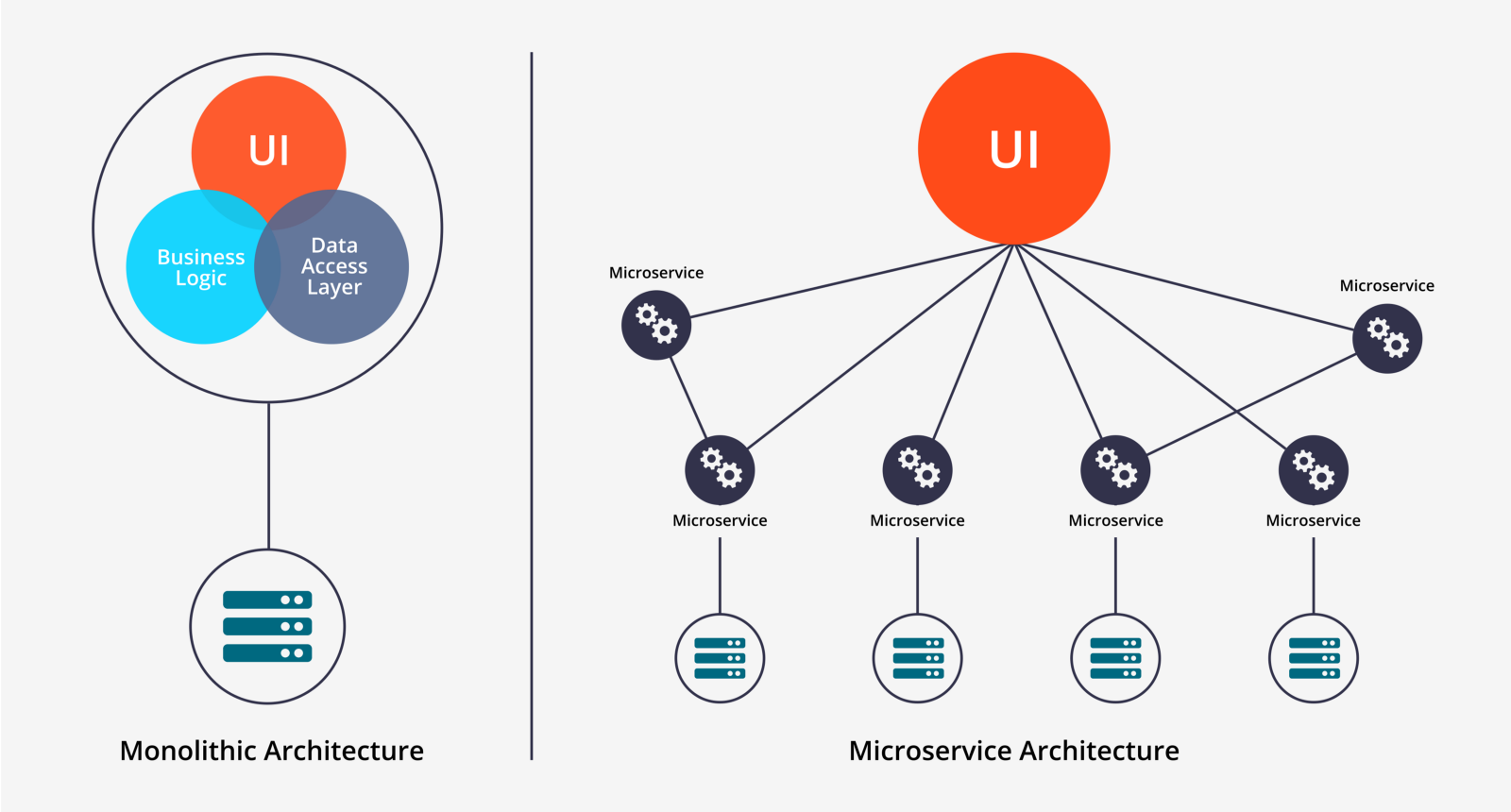What is Microservice Architecture?
Microservices Architecture allows developers to create separate components of application through building an application from a component of small services. Each of these services is built individually and deployed separately. Each service is flexible, robust, comparable and complete. They run as an autonomous process and communicate with each other through APIs.
Is your monolithic application hindering your team's agility and scalability? Discover how transitioning to a microservices architecture can revolutionize your development process.

You’re not sure, if using Microservice Architecture will work for your business? Keep reading to find out the key benefits of a microservice architecture.
Benefits of Microservice Architecture
1.) Improved Scalability

Architecture of Microservice is based on small components, each of your services are separate, you can easily scale up or scale down the services at the appropriate times. Isolation allows apps to run correctly when massive changes are happening. Microservices prove to be the perfect approach for companies working with various platforms and devices.
Let’s consider an example of, A large online market place Airbnb, it started with a Monolithic Architecture build on Ruby on Rails. This solution worked perfectly at the beginning since it was cheaper, faster and require fewer specialists. However, as the company started growing, they faced ample problems connected with the growing complexity of the platform. Airbnb then decided to break their Monolithic Architecture and started migrating to microservice Architecture. Today, Airbnb has improved page load productivity up to 10 times and providing every user 100% availability.
Microservices benefits over Monolithic
As businesses grow and user demands evolve, monolithic architectures often become bottlenecks:
- Scalability Without Complexity: Scaling monolithic applications can be inefficient, as it requires scaling the entire system, even if only one component is experiencing high demand. Microservices enable targeted scaling, optimizing resource usage while maintaining system stability.
- Resilience and Fault Isolation: A single failure in a monolithic system can cause widespread disruptions. Microservices, on the other hand, operate independently, ensuring that failures in one service do not impact the entire application, improving uptime and reliability.
Microservices are not just a trend; they are a strategic advantage for organizations aiming for agility, scalability, and resilience.

Abhinav Dubey Solutions Architect, Devtron
Abhinav Dubey is a Solution Architect at Devtron where he specializes in building robust and scalable Kubernetes infrastructures. As an active maintainer and contributor to Devtron, he is dedicated to democratizing Kubernetes adoption. Abhinav is also a CNCF Ambassador and an AWS Community Builder, reflecting his commitment to sharing knowledge within the cloud-native community.
2.) Failure and Resource Isolation
Microservices are profitable due to their isolation and resilience. Applications become easier to build and maintain when they are split into a set of smaller, composable fragments. Managing the code is no longer an irksome task, as each microservice is a separate block of code. Each service is independently managed and deployed.
For Example: When one of the microservice allocates too much memory or puts a heavy load on the processor, it will only affect this particular microservice and will not impact the entire system. Also, if any failure occurs in any of the individual microservices, it can be compensated quickly since each microservice is isolated from another microservice.
3.) Independent Team Collaboration
Microservices Architecture can easily align with practices such as Agile, DevOps and Continuous Integration(CI) /Continuous Deployment(CD). When companies adopt such practices they can easily transform internal culture, workflows and automate manual processes, and speed of Deployment gets increased dramatically.
When you use the Microservices Architecture for your company, you allow different development teams to work on different modules simultaneously and make technical decisions quickly in smaller teams. Thus, carrying out the development of a massive system becomes very easy, especially when you are working with divisions around the globe or extended teams.

Let’s consider the example of Netflix, back in 2009, Netflix decided to move from Monolithic Architecture to Microservices Architecture due to increasing demand of it’s services. It had a team of 25 engineers and they started facing difficulties collaborating and working on one product became an irksome task. And, now because of the implementation of a Microservices Architecture, Netflix has decomposed one team into more than 30 engineering teams and they all can work independently with much ease.
4.) Flexibility in Using Technologies and Components
As you know, each microservice can be written using a different technology. It simplifies the selection of the most appropriate tech tasks for the specific needs of your service. The microservice architecture allows decoupled services written in different programming languages to peacefully coexist with other fragments.
With a microservices architecture, you can add, replace and remove different components in the system without causing any ripple effects, bugs and errors in the entire system, since each of the services work independently without influencing other microservices.
For Example: If you have a website, you can easily add and remove different sections of the website as and when needed. It is especially important for event sections. When an event is over, you can easily remove the section for the event without changing the Website’s main functionality. Thus, you can swiftly improve the replaceability and upgradeability of your system when you use the Microservice Architecture.
5.) Reduced Response Downtime
For many big companies, reducing the response downtime is extremely crucial, Microservice Architecture is a perfect solution for a growing product and an agile team.

Let’s consider an example of, A huge retailer like Walmart, response downtime plays an important role. Once the company reached 6 million page views per minute, and it was impossible to manage such a huge growth. Then the company decided to move to the Microservice Architecture from monolithic Architecture. After that, the results were amazing, the downtime was minimized to a large extent and Walmart was able to save up to 50% on operating expenditures.
Conclusion
Microservices offer a unique kind of modularization. They make big solutions easier, increase productivity, offer flexibility in choosing technologies that are great for distributed teams. If you have a large project, need quick and autonomous delivery, plan to scale your solution or need to frequently update separate parts of your system, Microservices Architecture is best for you.
FAQ
What is Microservices Architecture and How Does It Work?
Microservices Architecture involves building applications from small, independent services that communicate via APIs. This approach offers flexibility, scalability, and resilience for large applications.
What Are the Key Benefits of Microservices Architecture?
Microservices improve scalability, fault isolation, technology flexibility, and reduce downtime. They allow easier management and enhance system resilience by isolating failures.
How Does Microservices Architecture Improve Team Collaboration?
Microservices enable teams to work on different components independently, speeding up deployment and improving efficiency through Agile, DevOps, and CI/CD practices.
Why Should Businesses Transition from Monolithic to Microservices Architecture?
Transitioning to microservices enhances scalability, reduces downtime, and allows for faster updates. Companies like Netflix and Walmart have seen improved performance and flexibility by migrating to microservices.



